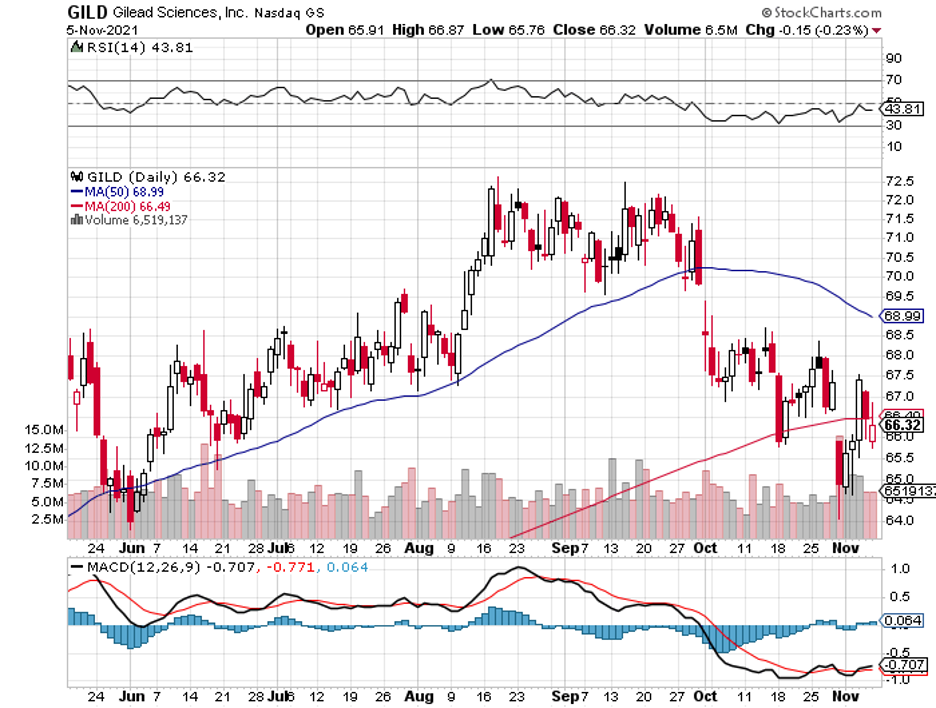At times, it can be rewarding to go against the tide. This can also be applicable to the stock market.
Forgotten names or companies with shares that got hammered can eventually transform into remarkable investment opportunities. After all, it's always wise to invest in a quality stock when it loses some serious altitude.
Now, let's take a look at a biotechnology and healthcare business that has been performing poorly in the past 12 months but still holds a promising chance of bouncing back: Gilead Sciences (GILD).
This biotechnology giant is still reeling after its recent regulatory setback involving Filgotinib, a potential treatment for rheumatoid arthritis.
Initially, Filgotinib was slated as Gilead Sciences' next blockbuster drug. Unfortunately, the US FDA didn't agree with those plans.
The regulatory body rejected the treatment, pointing out the risks of patients developing male fertility problems as one of the significant reasons.
By November 2020, Gilead Sciences completely abandoned the Filgotinib project, at least in the United States.
Prior to this, Gilead Sciences took center stage when its Remdesivir, sold under the brand name Veklury, was identified as an effective COVID-19 treatment.
While this product has taken the back seat since other treatments from the likes of Regeneron (REGN) and especially vaccines from Moderna (MRNA), Johnson & Johnson (JNJ), AstraZeneca (AZN), Pfizer (PFE), and BioNTech (BNTX) have emerged, it still generated impressive numbers.
In the second quarter alone, Veklury brought in $829 million in revenue.
Gilead Sciences anticipate sales to reach somewhere between $2.7 billion and $3.1 billion for this drug in 2021.
Arguably, though, the biggest draw in buying Gilead Sciences stock is its HIV pipeline.
To date, the company holds roughly 75% of the market share in the US and approximately 50% in Europe.
What's even more promising is that the company's top-selling HIV product, Biktarvy, still has vast room to grow.
This is impressive considering that Biktarvy raked in approximately $2 billion in sales in the second quarter of 2021, showing off a 24.3% year-over-year jump.
Looking at its trajectory and considering that the drug generated $7.3 billion in 2020, Biktarvy sales are estimated to hit $11.7 billion in 2026.
More than the company's incredible dominance in cornering the HIV market, Gilead Sciences also has an excellent pipeline with over three dozen clinical programs queued.
Inevitably, one of its major concentrations is expanding its HIV portfolio.
In fact, it has recently teamed up with fellow biotechnology giant Merck (MRK) to collaborate on a potential HIV treatment—a candidate that's anticipated to equal if not surpass Biktarvy's fame.
One more potential blockbuster in the HIV market is Lenacapavir, which is an injection regiment that Gilead Sciences recently submitted for approval to the FDA.
If granted the green light, this will be administered once every 6 months, making it the first-ever long-acting regimen for HIV patients.
Meanwhile, the company is also growing its Hepatitis B franchise to avoid being too dependent on a single market.
So far, Gilead Sciences estimates about $1 billion in sales for this lineup in 2022, making the Hepatitis B portfolio a reliable part of the business.
Another growing section of the business is its cell therapy segment, with Yescarta and Tecartus nearing their peak performances at $1 billion in sales yearly.
Even its newly developed cancer cell therapy Magrolimab looks promising, with the potential to rake in another $1 billion in peak sales as well.
Needless to say, Gilead Sciences' new products and expansions have been displaying realistic potential to drive billions in added yearly revenue.
Overall, Gilead Sciences is a stable and profitable biotechnology and healthcare business.
It's a large-cap biopharmaceutical organization and market leader that has been solidly performing well for over 3 decades, with an influential presence in more than 35 countries.
Despite its recent challenges, Gilead Sciences remains an excellent buy, especially on the dip.


